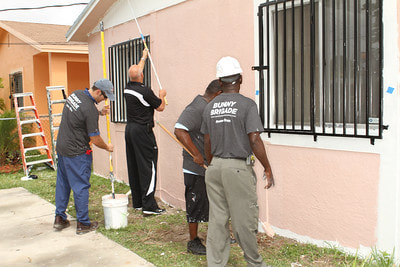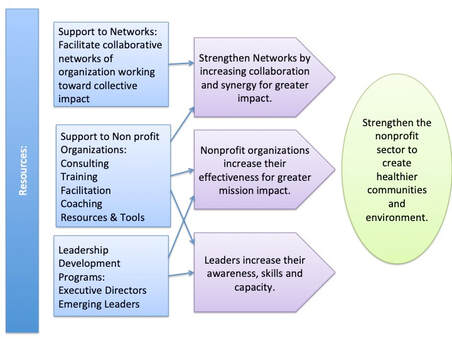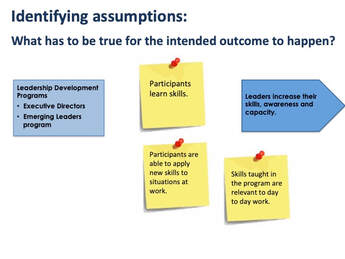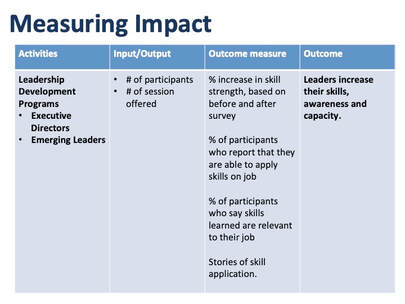Mission: Impact podcast & blog
Build a better world without becoming a martyr to your nonprofit cause
Listen on:
|
Nonprofit funders expect your nonprofit organization to be able to demonstrate its impact. While there are many ways to approach this, building out your organization’s theory of change and your program level logic models is an important step. We will explore what a theory of change and logic model is, why it is important and how it can help your organization measure the impact of the work you are doing. Understanding the Nonprofit Logic ModelA logic model maps out what it takes to deliver a program, service or area of work within the nonprofit organization. It details the assumptions embedded within the program and its short-, medium- and long-term outcomes. It also visually maps the program building blocks including inputs, activities, outputs. With this mapped out, you then can design an evaluation process and system to capture data on whether the program is producing the expected outcomes. The logic model breaks out in more detail one element of an organizational level theory of change. For example, a local watershed organization may focus their work in three areas – education, citizen science and policy work – to further its mission of contributing to a healthy watershed. Each work focus area mapped out in the theory of change would then have its own logic model. What is a theory of change?A theory of change shows visually and in writing how your organization’s work connects to and moves your mission and vision forward. A logic model maps out what it takes to deliver a specific program, the assumptions embedded within it and its short-, medium- and long-term outcomes. Taking the time to work together to create both will make apparent gaps in logic, understanding and agreement about what you are trying to achieve within your organization. It provides you with the opportunity to work through these to come to a shared understanding and vision which strengthens your work and organization. 4 Steps to Building Your Logic ModelAfter you have worked collectively to create your organization’s theory of change, you can work on creating each work area, service, or program area’s logic model.
From Theory to Practice: Implementing Your Logic ModelOnce your logic model is complete, you can then decide what performance measures you will focus on and how you will collect data on those measures. These data do not all need to be quantitative. In addition to quantitative data collected through surveys, often qualitative data including gathering stories and experiences through interviews will be an important component of the evaluation design. Measuring and Mapping ImpactWith this process, there can be the temptation to start collecting data about everything and then get overwhelmed and over time the data gathering stops, or you have a lot of data that you do not have time to synthesize and make meaning of. Keep it simple and choose a few key items to track so that you have the time to do the truly important work – learning from your evaluation. What are you learning from your team conversations?As you collect data and synthesize it, you will learn more about the effectiveness of your program. You may identify areas in which your hypotheses were not entirely accurate. What can you learn from the information? Apply your learnings by adjusting the program. This may mean tweaking your logic model as new information is gathered. Communicating results to your stakeholdersThe information you gather will have many applications. In addition to reporting results internally to your staff and board as well as to funders, you might highlight results on your webpage, blogs, social media, and annual reports. As you are doing so, consider each audience and their interest and perspectives. What do they care about and how can you link what you are doing and your results to that? Ask this question for each audience as you decide what aspects of your results to share. Just producing one findings report misses many opportunities to tell your story and share your impact. Overcoming 3 Common Challenges to developing a logic modelNot connecting the theoretical processes to practical applicationThese processes can seem a little esoteric. It helps to have an evaluation facilitator help walk you through the process. One of the common sticking points is the difference between an output and an outcome. You are likely already tracking outputs – how many people showed up to a training or the number of times you have testified before government decision makers. But what are you expecting people to be able to do after the training – answering that question helps you start identifying outcomes. A facilitator can keep the conversation going, help everyone understand the purpose of each step and ensure all the items are captured s as the group brainstorms. Realistic expectations of what your data are telling youOther objections to engaging in this work have to do with whether you can prove your program, service or intervention is THE factor that creates the outcome. Organizations rarely have the resources to evaluate their programs at that level, including running double-blind tests. While you may not be able to invest in evaluation to the level that will enable you to prove your impact, you can design a system that help board and staff to continue to strengthen the program as well as gather evidence of your impact. Does not represent the full complexityAnother pitfall is rejecting logic models because they cannot fully capture the complexity of the system that program participants are living within or are themselves. Indeed, the map is not the territory. No model will fully capture life in its full complexity. Yet it can provide a slice of that reality that your work is focused on. With these understandings in mind, you can proceed with more realistic expectations for what a logic model, monitoring and evaluation can do for your organization. Nonprofit Logic models are worth the investmentInvesting the time in mapping out your organization’s theory of change and logic models is an important aspect of ensuring your stakeholders are aligned on your organization’s strategy. The process can reveal and then address gaps in logic, understanding and agreement on how each aspect of your work contributes to your overall mission. Tackling this as a collective project helps educate everyone involved not only about the process itself but also about why and how you do what you do. It can contribute to breaking down silos within your organization. With the information you collect because of this work, you are also better able to tell your story of results to donors, funders, board members, volunteers, community partners and decision makers.
Is strategic planning worth the effort? Frequently organizations are concerned whether it will be time well spent, whether the plan that gets created will get implemented. Here are two stories of the impact strategic planning had on two small organizations that prioritized getting intentional about their future. Keeping Growth & Momentum Going Photo by RUN 4 FFWPU from Pexels Photo by RUN 4 FFWPU from Pexels Challenge: A local disability focused service nonprofit spent the last several years strengthening its board, its financial footing and documenting processes for its signature events. After this strengthening process, the leadership decided it was in a good position to be more deliberate about deciding its future direction. Approach After interviewing key stakeholders and conducting focus groups of board members, I shifted what was planned as a full day retreat to two online sessions. The goal of the sessions was to define the organization's key goals for the next 3-5 years. During the online sessions, the board
Results The organization now has a new strategic plan with clear support from the organization's leadership. The process helped the group celebrate the strides they had taken over the past several years. They were able to acknowledge their success and build on that positive momentum to move forward with focus and direction. A lesson in letting go  Cristofer Jeschke on Unsplash Cristofer Jeschke on Unsplash Challenge: A local environmental nonprofit had been volunteer-led for most of its 30 years. In the past five years, it had hired its first executive director and added several part-time staff. The organization had not successfully undergone strategic planning and its vision was primarily directed by its founding board members. The organization had a very large board that was still very involved in day-to-day operations. Approach I interviewed and conducted focus groups with key board members. Board members conducted interviews with external stakeholders. I facilitated two online sessions to define the organization's key goals for the next 3-5 years. During the online sessions, the board
Through these sessions the board and staff were able to recognize ways in which how they were operating was getting in their own way and make plans to adjust. They had tough conversations about what the role of the board and the staff needed to be going forward and how to make working together a more positive experience. Results The nonprofit organization now has a new strategic plan with clear delineation of roles and responsibilities as well as action items and key performance indicators. This is the organization's first strategic plan that was developed as a shared vision. Nonprofit organization often value participatory decision making. Yet often nonprofit leaders think the only way to achieve participation is to strive for consensus. Groups often fear working on a consensus basis because they are afraid of the time it will take to make a decision. They are afraid of being caught in a spiral of discussion, more discussion and yet more discussion and no resolution. They may be afraid of this because they may assume that everyone has to be 100% behind a decision for the group to move ahead. When a group is considering an issue, ideally there is a discussion that considers a wide range of options. Then the discussion comes to a clear end point with a decision. Once a decision is made the group moves to action. This image illustrates this ideal. Americans tend to be quite action oriented and in our culture we can get impatient easily, wanting to jump to a decision. And thus more frequently it feels like this: Part of the group thinks a decision has been made and others thinks the item is still up for discussion. And still others may not be clear what decision is on the table. Consensus continuumOnce the nonprofit group is clear about what they are deciding, a useful tool for testing the level of agreement is the consensus continuum. Applying the continuumI was part of a nonprofit board that used this continuum when it was deliberating about a very challenging situation. There was no good solution to the high stakes problem we were facing. There were only several bad choices to choose from. Which bad choice was better than the other? We deliberated for a long time. Deliberation happened over multiple meetings, over multiple weeks. Ultimately we were able to make a decision that everyone in the group could live with even if it was not their preferred option by using this tool. How many people you need to have in the 1-3 zone will depend on how high stakes a decision it is. Using this as a check in can move along even decisions that may seem like they are low stakes but are taking a long time. You may find it is higher stakes for some in the group. There was no good solution to the high stakes problem the nonprofit board was facing. There were only several bad choices to choose from. Which bad choice was better than the other? We deliberated for a long time. Deliberation happened over multiple meetings, over multiple weeks. Ultimately we were able to make a decision that everyone in the group could live with even if it was not their preferred option by using this tool. Making time for processNonprofit groups often want to jump to action and resist taking time on ‘process’ issues. Being clear about how the group makes decisions is a core process issue that rarely gets discussed. Taking the time can actually save the group both time and angst in the long run.
Have a group that needs help with how they are working together? Reach out for a coaching session.  Photo by El Gringo, Miami Habitat for Humanity Photo by El Gringo, Miami Habitat for Humanity Your nonprofit organization is designed for a specific mission with the goal of having an impact in the world. The world will be different in some way because of the work you do. Homeless people are cared for and fed who wouldn’t be otherwise. First generation college students increase their understanding of financial aid so that they can make better decisions about paying for their education. They’d make costly mistakes without you. Emerging leaders in marginalized communities are supported to strengthen their self-awareness and skills so that they can advocate for their community. You undertake the activities and programs with the aim of furthering your mission. Have you taken the time to look at how all the pieces fit together and whether it all adds up? Creating a picture A sample impact map of a capacity building organization. A sample impact map of a capacity building organization. When you create an impact map also known as a logic model, you create a visual representation of what your organization is doing and how it creates the impact you want to have in the world. It makes clear how you leverage resources and organizational capacities to deliver your core strategies to achieve tangible results. By creating an impact map, you are able to create a model that illustrates your beliefs about the change you are trying to make. Identifying assumptions Sample outcomes and indicators. Sample outcomes and indicators. It also can help you uncover the assumptions inherent in your programs and activities. You can also describe what short, medium and long term outcomes you believe result from each program or activity. A good question for identifying assumptions is to ask, “what has to be true for this outcome to happen?” These essentially are the hypotheses embedded in your program design. Are there gaps in logic? Are you measuring inputs and outputs or outcomes? Are you measuring inputs and outputs or outcomes? Once you have created your map and identified the assumptions inherent with each program, you can consider how you might measure whether you are having the mission impact you are aiming for. An impact map can also uncover gaps in your logic. Creating shared understandingEngaging in the process of impact mapping can be a useful exercise for staff and/or your board. Have small groups create an impact map of your organization. Then compare the maps. Do people envision the same organization? Where are the gaps in knowledge and understanding?
Once you have agreement on your organization’s impact map, take it one step further. Have a conversation about the implications of the map. Ask questions such as:
Think this might be helpful for your organization and would like some help? Inquire about a coaching session. What does all this growth mean for our nonprofit going forward? Photo by Felix Mittermeier from Pexels Photo by Felix Mittermeier from Pexels Challenge: An education related organization had accomplished all the key goals in their current strategic plan. Over this period, the organization experienced substantial growth both in the number of clients it was serving as well as the scope of the services they were providing the field. With the increased staff strength, the board had become accustomed to relying on staff for direction and strategic thinking. The organization needed to assess the implications of this growth, ensure that there was alignment of staff and board in order to set direction and clear goals for the next 3-5 years. Approach: After interviews with each of the board members, and external stakeholder interviews as well as focus groups with staff, I facilitated a one-day retreat with the board and staff leadership. The retreat focused on: • conducting an environmental scan to identify key trends impacting the organization’s work, • reviewing the themes from the interviews and focus groups and discuss their implications • envisioning the organization’s future impact on the field, • resulting in identifying two to three key strategic goals for the organization. Results: The organization now has a new strategic plan with clear support from both the board and staff leadership. The process helped the board step into its strategic role. Board meetings now have time dedicated to focusing on strategic questions. Staff leadership was also able to recognize how some of their actions encouraged the board to rely on them. Thus they are now equipped to make different choices moving forward. They can be clearer about what is staff work and what is the board’s responsibility. Are our board and staff focused on the right things? Photo by Mark Arron Smith from Pexels Photo by Mark Arron Smith from Pexels Challenge: A local land trust organization had a regular good practice of conducting a board self-assessment each year. Over the past couple years, a few indicators created some concern. The group decided it would benefit from outside facilitation for its annual board staff retreat to dive into the issues raised in the self-assessment, including roles and responsibilities between board and staff. Approach: In addition to the board self-assessment results, I conducted a survey of staff and board. My goal was to learn about the board’s current concerns and to understand the staff’s perspective on the organization’s current state. During the retreat, after a brief presentation on nonprofit life cycles, the group considered where their organization stood in its development. I then shared the themes from the survey and had the group discuss the implications. Board and staff learned that they had more in common than they thought on their perspectives of what the organization needed to improve in terms of operations. It also became clear that the board was eager to stay at the governance level and focus on longer-term strategic issues. Through small group work, the groups considered its current initiatives and areas for future development and sketched out next steps. The group then gave each small group feedback. Results: Through the retreat, the board and staff were able to open up conversations focused on roles and responsibilities that they had had some trepidation about addressing. The conversations revealed more agreement than individuals had expected. The group identified areas for growth and left with increased clarity on roles, goals and next steps. |
Categories
All
Archives
July 2024

Grace Social Sector Consulting, LLC, owns the copyright in and to all content in and transcripts of the Mission: Impact podcast, as well as the Mission: Impact blog with all rights reserved, including right of publicity.
|
Telephone301-857-9335
|
info[at]gracesocialsector.com
|
Grace Social Sector Consulting, LLC, owns the copyright in and to all content in, including transcripts and audio of the Mission: Impact podcast and all content on this website, with all rights reserved, including right of publicity.
|